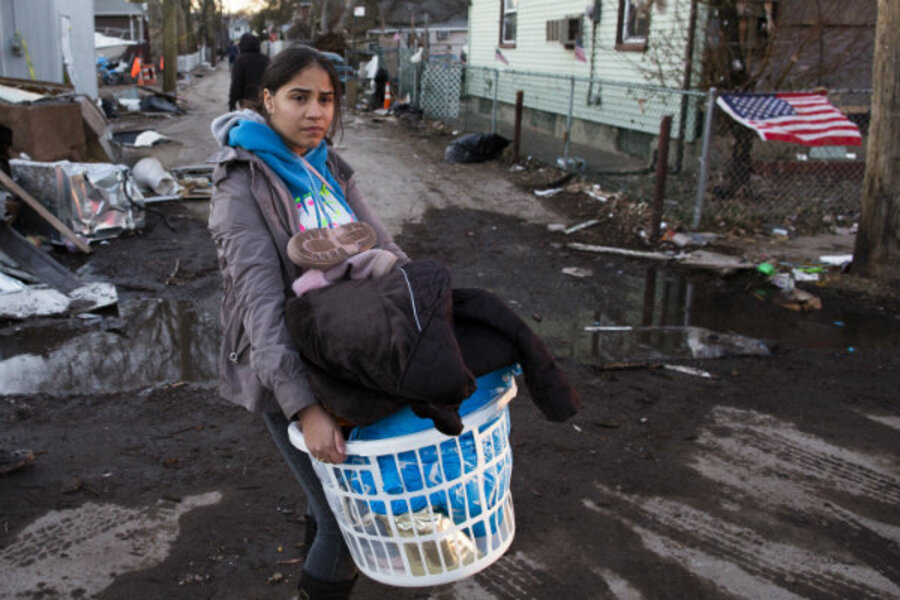Finding uncommon community after superstorm Sandy
| Brooklyn, N.Y.
Natural disaster begets uncommon intimacy.
One moment, we were standing under the muddled sun in New Dorp, a neighborhood that sits on the outermost edge of Staten Island. The next, we were bagging linens in the bedroom, trashing chicken cutlets out of the freezer in the basement, rubbing the slumped shoulders of a perfect stranger whose old wedding dress hung dripping on the muddy wooden floor.
We could have ended up at any house, on any number of streets that had, just days earlier, been ocean. But it was to this older Italian couple’s home that the volunteer coordinator sent us.
When the water came, they told us, it came so fast. First there were just puddles. Eight minutes later their basement had become a fish tank. As the water level rose three feet into their kitchen, they escaped.
As we worked that day, we escaped something, too – a certain kind of city life where encounters like this are dangerously rare. Most days, we email. But today, we worked. And as we carried their things from their humble two-story home onto the street out front, we came to know them.
For one, they love to look sharp. Has one man ever owned so many ties? Or pinstriped suits? They just kept coming, drenched from collar to cuff. She, too, had to relinquish a silk, black coat with brown fur trim, a piece of clothing that had no doubt transformed how she felt about herself at some important moment. We threw it with the rest of the stuff – the DVDs and the impossibly heavy terrycloth robe and the remote control, as if it were just another thing.
They love gardening. The shed was filled with every kind of tool, now rusting in a plastic bucket of water. There were a dozen plastic drawers, each filled with seawater – seeds and nails and hinges swimming inside. There was a garden sign that said, “Take time to stop and smell the roses.” It stuck out of the mounting garbage pile in front of their dying home like some kind of cruel joke.
Other volunteers came and went. One pair forced a damp leather love seat through a doorframe, punctured a little hole in the rose-colored kitchen wall, then kept moving. A pair of would-be marathoners from Malta came, too. They wore their disappointment lightly, along with their spandex.
Another crew only spent a few minutes trudging through the house, then decided, in an indiscreet huddle out front, that the homeowners were getting rid of perfectly good furniture because they were trying to scheme more money out of their misfortune. I was stunned. And unconvinced.
In “A Paradise Built in Hell,” Rebecca Solnit wrote that in disasters, “how you behave depends on whether you think your neighbors or fellow citizens are a greater threat than the havoc wrought by a disaster or a greater good than the property in houses and stores around you.”
We couldn’t turn away from the greater good of these two random human beings that Sandy had introduced to us – this woman, her hair thin on her head, worry on her face, or this man, hobbling around on his cane, telling us what to keep and what to pitch in his thick Italian accent. Plaster puppy statue – keep. Wicker bench – pitch. Painted plates – keep.
I looked around at my husband and our three dear friends, Brooklyn creatives all covered in mud, faces obscured by hospital masks, shoveling densely matted drywall in heaps on the driveway into a wheelbarrow, wordlessly.
The physicality, immediacy, and selflessness – not heroism, but literally the disappearance of the self – was dignifying.
They said that we could come back a year from now and all raise a glass together. It was their way of saying thanks. I smiled and told them that I looked forward to it, even as I knew that it would never happen.
But that’s okay. It was never about that.
Courtney E. Martin is the author of “Do It Anyway: The New Generation of Activists” and the co-founder of the Solutions Journalism Network. You can read more about her work at www.courtneyemartin.com.





